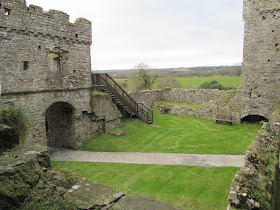Today marks the anniversary Piers Gaveston surrendered to Amyer de Valance, Earl of Pembroke, after a short siege at Scarborough Castle. The castle was probably not prepared for a long siege and Piers surrendered on very good terms. He would accompany Pembroke to York where some sort of 'deal' would be done. Edward II was at York and if no deal could be reached, Piers would be returned to Scarborough Castle and no doubt be prepared for a long siege. As we know, things turned out differently.
Today also marks the execution of Anne Boleyn at the Tower of London in 1536.
Not a great day for this history fan!
This blog is dedicated to Piers Gaveston, Earl Of Cornwall. Piers, also known as Perrot, was the favourite of Edward II. Depending on historical interpretation, the definition of 'favourite' ranges from 'brother', 'beloved friend' or 'lover'. This blog will be a mix of historical narrative, personal opinion and hopefully some lighter postings! The Plus will cover other historical matters.
Thursday, 19 May 2016
Monday, 9 May 2016
Rhys ap Thomas - the man who killed Richard III?
My last post dealt with my visit to Leicester and the Richard III centre, as well as to Richard's tomb in the Cathedral. In the exhibition centre there was a mock-up of Richard's skeleton and the wounds inflicted upon it. In particular, there was focus on the wound at the back of Richard's head - the fatal blow that killed him. Legend has it, this blow was struck by Sir Rhys ap Thomas. He became one of Henry VII's most powerful supporters - and yet he had sworn his allegiance to King Richard and vowing that Henry Tudor would never set foot in Wales. This is the vow he allegedly made -
'Whoever ill-affected to the state, shall dare to land in those parts of Wales where I have any employment under your majesty, must resolve with himself to make his entrance and irruption over my belly.'
Rhys ap Thomas got round this vow by hiding under Mullock Bridge, so Henry Tudor did cross into Wales over Rhys' belly! Rhys quickly joined Henry Tudor's army and marched with him to Bosworth. The story that Rhys slew Richard is written about by the poet Guto’r Glyn (1412-1493), referring to King Richard’s emblem of a boar, wrote contemporaneously that Rhys “killed the boar, shaved his head”. Richard's skull was indeed shaved. Rhys was knighted on the battlefield and went on to serve Henry VII loyally, becoming a knight of the Garter in 1505 and becoming a privy councillor. He celebrated with a grand tournament at Carew Castle. Here are some photos from my last visit.
 |
| Approaching Carew Castle from the main road. |
 |
| The Arms of Henry VII and Prince Arthur at Carew Castle. |
 |
| The arms were put in place for a visit by Henry VII. |
 |
| Stained Glass Window added recently. |
 |
| The castle is now mainly a ruin, but well worth a visit. |
 |
| Inside the restored Great Hall. |
Above is the famous carving from Sir Rhys ap Thomas' bed which shows him at the Battle of Bosworth.
You can read more about Rhys ap Thomas in Susan Fern's book 'The Man Who Killed Richard III'.

